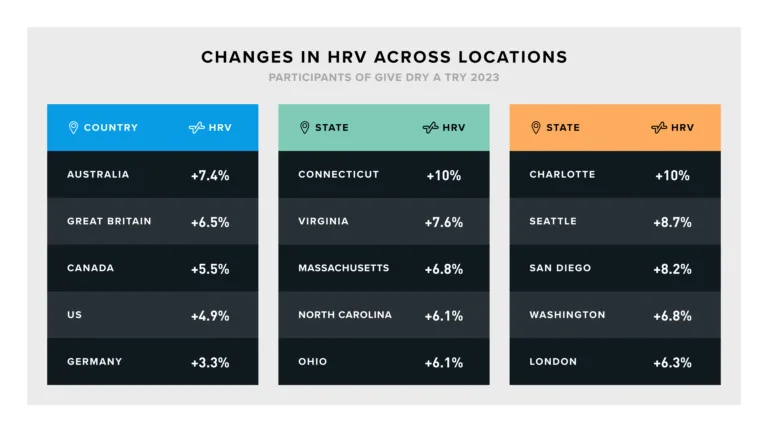Topics
- Article
- Alcohol
- Health & Wellness
- HRV
- Recovery
What Happens When You Give Dry a Try: How Reducing Alcohol Consumption Affects Physiology

Alcohol consumption is one of the most tracked behaviors on WHOOP — and for good reason. The data shows that alcohol consumption is one of the biggest influences on heart rate variability, resting heart rate, and Recovery scores. Here's what happened when the WHOOP community tried dry for the month of January.
On average, for every drink WHOOP members consume, resting Heart Rate increases an average of 1.3 bpm, HRV decreases an average of 2.4 ms, and Recovery decreases an average of 4.2%. This year, nearly 15% of adults stated they planned to abstain from alcohol in the month of January – with millennials the most likely to participate. And for those who have previously participated in Dry January, 72% planned to participate again this year, proving many find a period of low to no alcohol consumption valuable physically and mentally. Going into January 2023, WHOOP asked its members what goals they had for the new year — and reducing alcohol consumption among the most popular. WHOOP partnered with Athletic Brewing — America’s leading producer of non-alcoholic craft beer — this January to encourage people to Give Dry a Try and reduce their alcohol consumption, or completely go dry, if they opted to. Throughout the month, members logged their alcohol consumption, if any, in their WHOOP Journal, to stay accountable. We took a look at the data to see exactly how giving dry a try affected members’ physiology, from their sleep, to their resting heart rate, and more. Here’s what we learned.
MEMBERS REDUCED THEIR ALCOHOL CONSUMPTION DURING JANUARY
Overall, members who participated in the Give Dry a Try team reduced their alcohol consumption significantly during the month of January, on average decreasing the number of days they consumed by 25%. A whopping 94.5% of members reported fewer days with alcohol in January compared to their baseline. While most people reduced consumption instead of completely abstaining with 29% reporting alcohol on less than 10% of the days in January, 16% of members reported 0 days of alcohol in January.
REDUCING ALCOHOL IMPROVED HRV AND RECOVERY SCORES
Heart Rate Variability (HRV) is a measure of your autonomic nervous system and has proven to be an indicator of longevity and cardiac health. A higher HRV is generally considered to be more beneficial, although genetics play a factor in an individual's HRV. Members who participated in the ‘Give Dry a Try’ resolution group saw a greater improvement in their HRV and Recovery than the baseline WHOOP population. In fact, members of the Give Dry a Try resolution group saw an HRV increase 5x greater in magnitude than the WHOOP population.

Recovery scores are largely influenced by the HRV and RHR of an individual over time — hence why the Try Dry group saw the biggest changes to Recovery. In addition to HRV and RHR, the Give Dry a Try group saw slight improvements in their sleep metrics, including Sleep Performance, Restorative Duration, and Consistency (+0.7%). Because alcohol is known to disrupt sleep cycles, act as a diuretic, and lead to dehydration, reducing consumption can lead to better outcomes for sleep and specifically for HRV because the body has more opportunity to properly and amply recover. Female members saw a greater improvement to Recovery, while male members saw a greater improvement to HRV and resting heart rate.

WHO REDUCED CONSUMPTION THE MOST
Members participating in the Give Dry a Try resolution period were primarily from the United States (66%), followed by Great Britain (5.3%), Australia (1.9%), Canada (1.8%) and Germany (1.2%). When looking at which locations benefitted the most from trying dry, Australia emerged on top. Domestically, Connecticut saw the biggest HRV improvements, and on a city level, Charlotte, NC saw the most significant HRV improvements.

Members were encouraged to reduce alcohol consumption – and the biggest reduction in consumption rates came from the Netherlands, Washington, D.C., and Atlanta.

REDUCING ALCOHOL CONSUMPTION IS MORE THAN JUST A TREND
Over the past decade, Dry January, Dry July – popular in Australia and New Zealand – and Sober October have all seen an increase in popularity, with participation in Dry January peaking in 2022. But all signs point to this being more than just a trend. According to a recent survey, more than 75% of Americans say they’ve given up alcohol for at least a month in the past. For those who are trying to reduce their alcohol consumption, 52% are replacing alcohol with non-alcoholic beverages. Given the implications on heart rate variability, sleep, resting heart rate, and Recovery scores, it’s clear why trying dry is growing in popularity across the world. All data is voluntarily self reported, it is analyzed for trends/correlations but is not a controlled study.